This is a sample article from the January 2012 issue of EEnergy Informer.
Failure to meet the challenges facing the grid could be degraded reliability.
In the past few years, smart grid has risen to top of everyone’s favorite list of topics. Numerous studies and books are devoted to its many purported benefits, including one edited by this newsletter’s editor (see flyer). The latest on the subject is a report released in early December by the Massachusetts Institute of Technology (MIT).
Coming as part of a series of MIT reports looking at the future of coal, nuclear and everything else, this one is rather immodestly titled The Future of the Electric Grid. While comprehensive in scope, literally covering the A to Z of the smart grid, much of what it says has already been said elsewhere, but perhaps not in an integrated fashion – the report’s most significant plus.
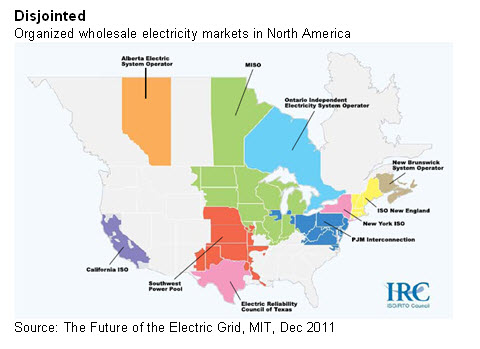
Starting with an overview of the complex North American electricity infrastructure and even more complex array of stakeholders, regulators and others who have a say in how it is organized and operated, the MIT report points out just how disjointed it is. In the absence of a coherent federal policy and with so many overlapping organizations and players, it is a miracle that the grid operates as well as it does.
Adding to this maddening complexity is the existence of some 3,200 distribution entities, some private, others publicly, municipally or government owned, each operating under different set of rules and regulations – and some with little or no regulation or oversight.
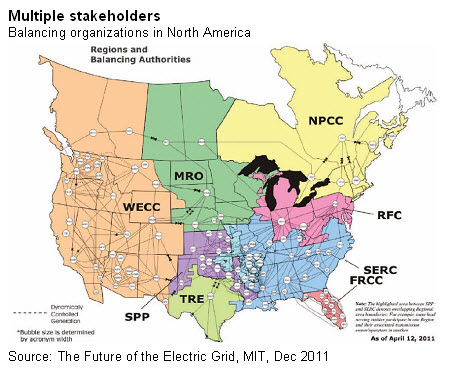
As repeated in all other studies of the smart grid, the MIT report identifies the need to integrate massive amounts of new renewable generation as the “most significant challenge facing the grid.” Increased penetration of electric vehicles (EVs) is also highlighted as warranting special attention (chart below).
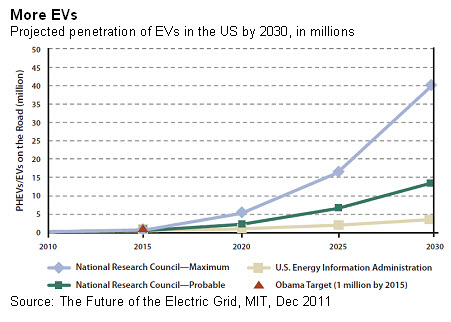
A chapter titled Engaging Electricity Demand covers various promising options to increase customer demand-side participation (DSP) in electricity markets, broadly defined. This, needless to say, is also the topic of multiple other recent studies as increased attention is focused on manipulating and managing both the volume and pattern of energy consumption by influencing customer behavior.
Referring to recent studies conducted by the Federal Energy Regulatory Commission (FERC), the MIT report examines a number of pricing and behavioral schemes to reduce peak demand, with and without enabling technologies. Like other chapters, it provides a good overview of the issues plus useful references.
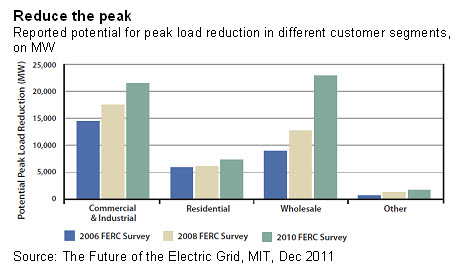
Among the report’s main conclusions is that FERC “should be granted enhanced authority to site major transmission facilities that cross state lines so as to make easier the integration of remote renewable,” a sensible recommendation but one that is easier said than done.
While FERC may welcome an “enhanced authority” to do more in transmission planning, routing, and pricing, not everyone in the industry would welcome such a thing. FERC’s proper role and reach, like those of other regulatory agencies, is controversial and hotly disputed. There are many among the stakeholders who would rather see a diminished, as opposed to an enhanced, level of authority for FERC.
The MIT report also recommends that, “utilities with advanced metering technology should begin a transition to pricing regimes in which customers pay rates that reflect the time-varying costs of supplying power.” English translation: introduce dynamic pricing once you are done with installing smart meters.
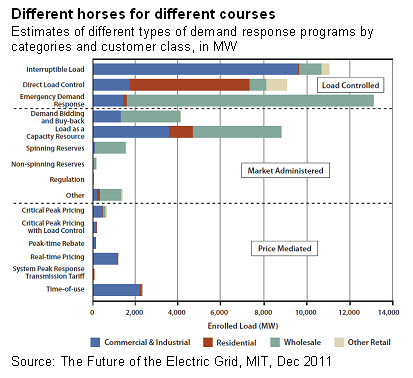
Another sensible suggestion, but one that requires state-level regulatory approval at multiple states, each with their own priorities, set of rules and timetables. The problem is that glaciers move faster than most regulators.
Having identified the opportunities facing the industry it cautions that “failure to realize these opportunities could result in degraded reliability, significantly increased costs, and a failure to achieve several public policy goals.”

